Greetings friends, I hope you are well.
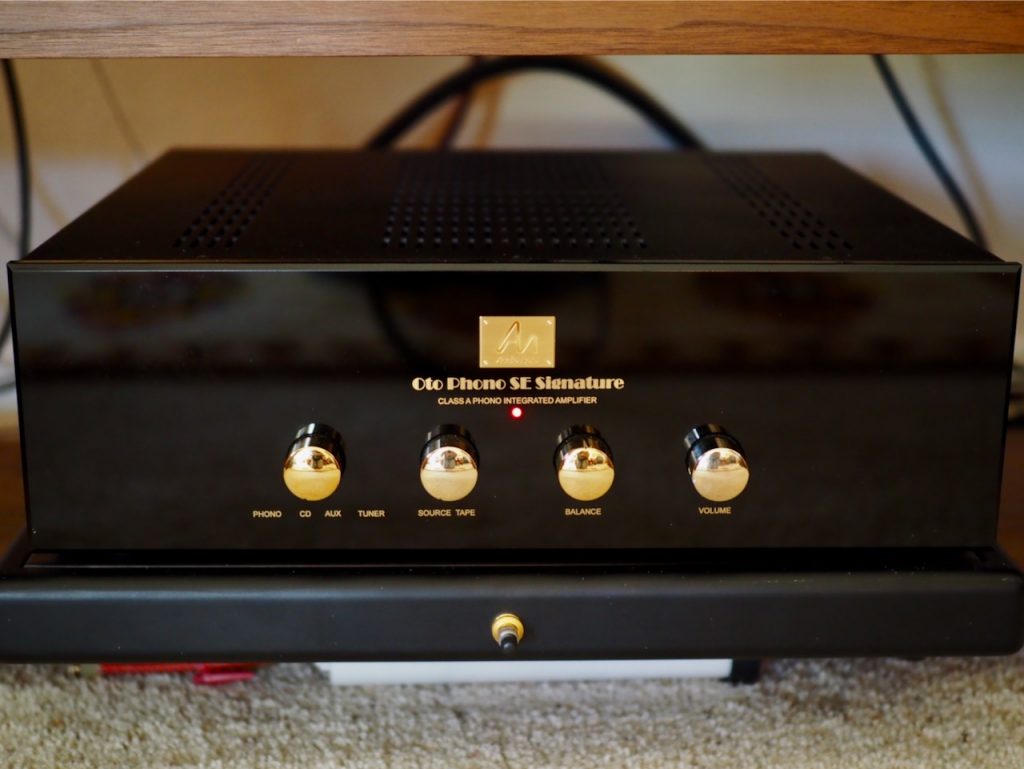
Audio Note (UK) Oto Phono SE Signature integrated amplifier.
I also hope you had a chance to read my feature article about the Audio Note (UK) Oto Phono SE Signature integrated amplifier in Positive Feedback Issue 108 (HERE).
The Audio Note (UK) Oto Phono SE Signature integrated amplifier arrived here at Jeff's Place in October of 2019, I wrote the feature article about it in March of 2020, and it is now March of 2022!
How time flies! It's already time for a long-term report on the Audio Note (UK) Oto Phono SE Signature integrated amplifier!
As a reminder, the Oto is a parallel single-ended-pentode design, built to impeccable standards, that puts out 10 watts of impressive single-ended power.

The Oto's output transformers.
The Oto powered my Westminster Royal SE loudspeakers with ease, something that amplifiers with twice the power couldn't always do as effectively.
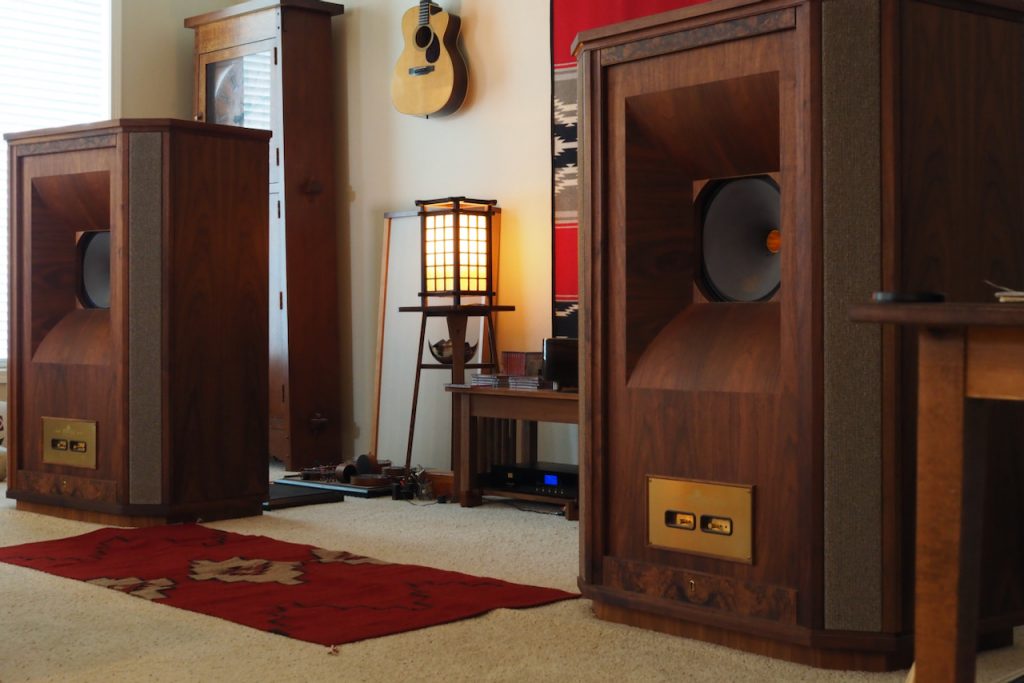
Tannoy Westminster Royal SE loudspeakers with Duelund CAST crossovers.
I've noticed that the ability of a vacuum tube amplifier to be able to drive my Westminsters effectively seems to be directly related to the quality of their output transformers.
The transformers in the Oto are first rate, and are custom built in-house at Audio Note (UK) to assure they meet Peter's high standards for transformers.
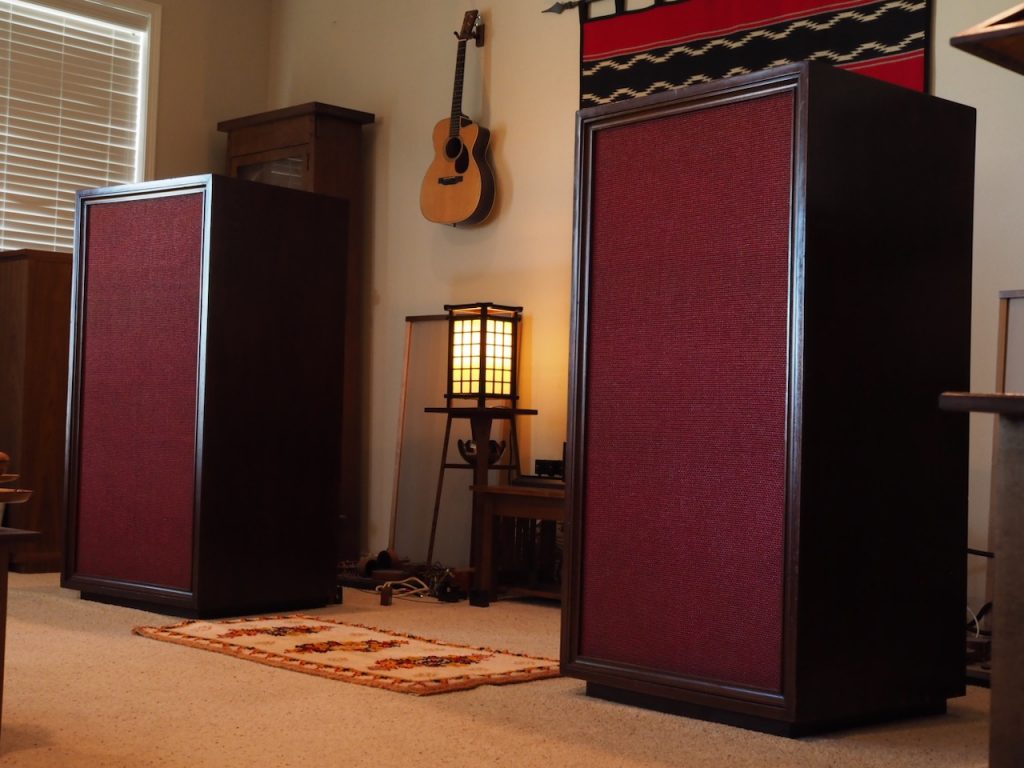
Custom vintage Altec loudspeakers built for conductor Leopold Stokowski.
The Oto was magic powering my custom 'A7-ish' vintage Altec loudspeakers that were built for conductor Leopold Stokowski way back when (above).
The resulting sound quality and musicality of that pairing resulted in one of those 'desert island' systems levels of performance that one dreams about discovering.
I fell deeply in love with this combination. You can read all about the 'Stokowski' Altecs in Positive Feedback Issue 105 (HERE).

Audio Note (UK) Oto Phono SE Signature integrated amplifier powering my vintage Altec A5s.
I thought for my longterm report on the Audio Note (UK) Oto Phono SE Signature integrated amplifier, I'd tell you about the Oto's performance in yet another system context, that of my audio-visual system that's based upon my vintage Altec A5 loudspeakers.
The Altec A5 loudspeakers began to appear in the North American movie theaters in 1945. The Altec A5s were intended to provide ample sound for the specific needs of small-to-medium sized movie theaters. For large movie theaters the gigantic Altec A2 or A4 loudspeakers were employed (more HERE).
Given the original intended use of Altec A5s in small to medium movie theaters, my A5s' crossovers needed to be redone to adapt the big beasts to smaller domestic listening environments.
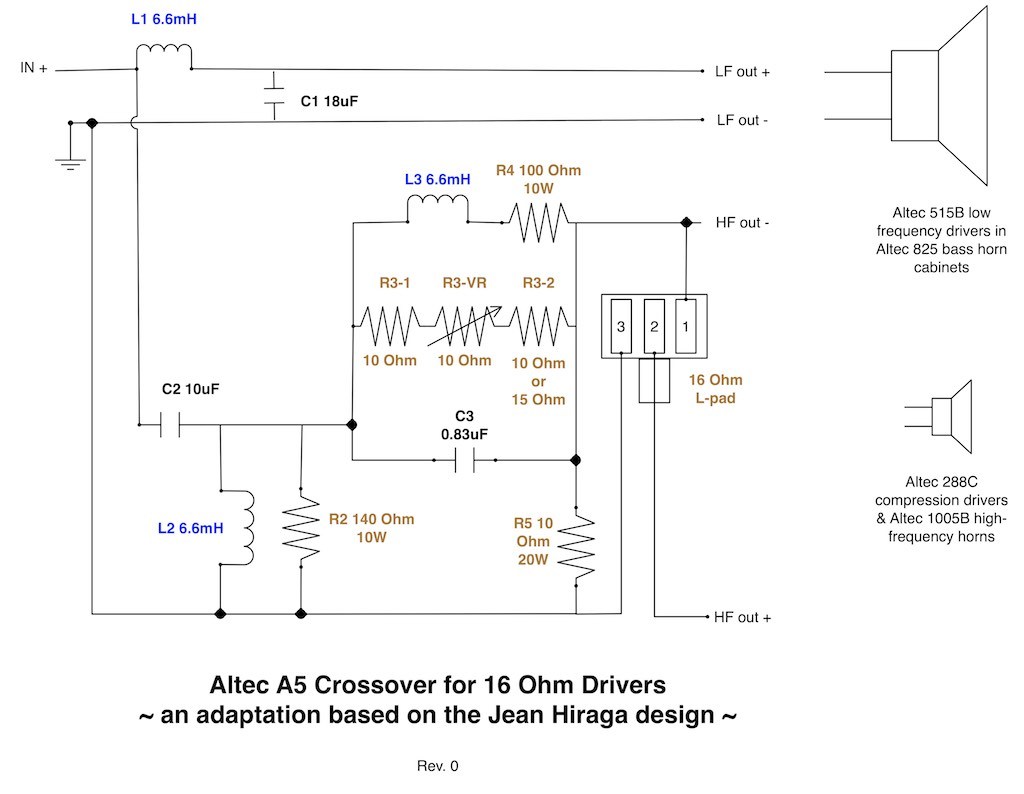
The crossover design I chose to use for my A5s is an adaptation of Jean Hiraga’s superb 16-Ohm crossover design for the Altec A5’s, with a few modifications recommended by friend Yazaki-san (a variable resistor) and Pete Riggle (Pete Riggle Audio Engineering, an L-Pad) to help blend in the 1005B high-frequency horns I’m using instead of the 3dB less sensitive 1505B horns that Hiraga-san used.

The Hiraga-san inspired crossovers of my vintage Altec A5s.
By default, audio enthusiasts often assume that the big A5s can't be used in smaller rooms, but that is not the case at all, as the big A5s are superb performers even in my rather small audio-visual room (a spare bedroom in my home).
To use the A5s in my small room I had to balance the output of the high-frequency Altec 288C drivers to match that of the low-frequency Altec 515B drivers using the aforementioned variable resistor and L-Pad recommended by Yazaki-san and Pete.
It took a bit of trial and error to get everything dialed in for the room size, but once done, it was/is a magic combination for audio-visual enjoyment.
Once the crossovers are adjusted properly the big Altec A5s provide an exhilarating and completely immersive listening/viewing experience from video and audio sources.
There's just something special about hearing those big A5 theater loudspeakers perform in my audio-visual system, and with every session they hearken me back to my youth when I would visit small town American movie theaters to be thrilled by what I heard and watched from the movies. Goosebumps!
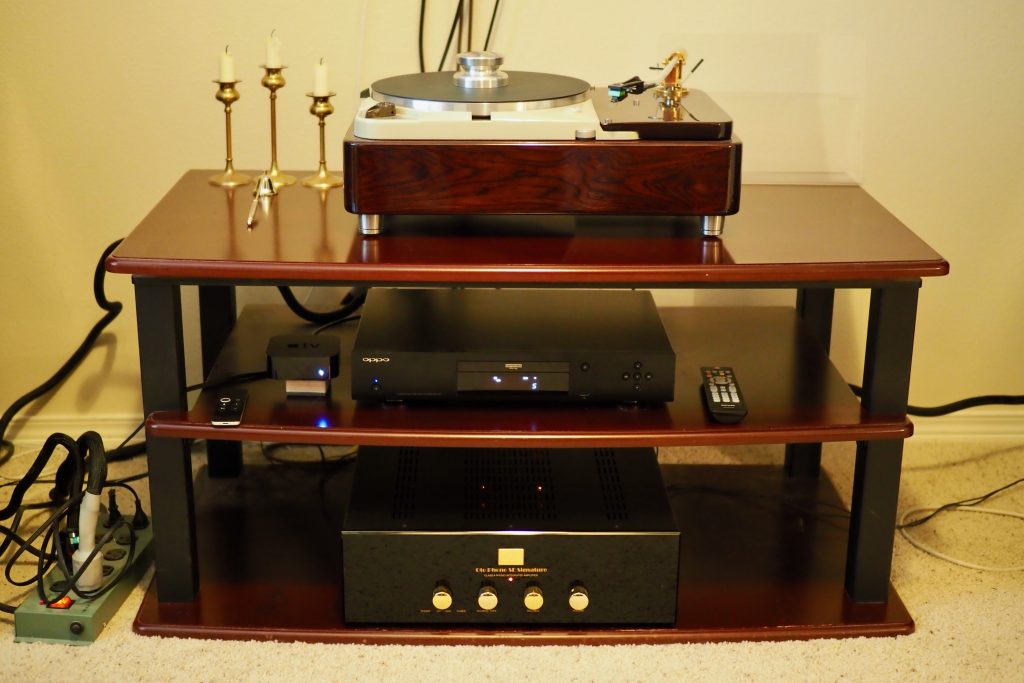
Audio Note (UK) Oto Phono SE Signature integrated amplifier.
Back to the Oto and my longterm report.
Installation into my audio-visual system couldn't have been easier with the one-box Oto, and it provides a very clean and simple system setup, as you can see in the photo above.
For speaker cables I use unterminated Duelund DCA16GA tinned-copper wire for the best performance in this system context. I know, unterminated speaker cables are a 'hair shirt' approach, but they sound better that way, as the audio signal doesn't have to go through additional signal degrading solder joints and connecters. Less is more in this case.
For interconnects I am using Belden 8402 tinned-copper microphone cable interconnects, an old recording studio standard, and one of my favorites performance-wise for their natural tonal balance and their very "real" sound quality, with the additional bonus of being inexpensive. More about the Belden 8402 HERE.
Power cables are a mix of Sablon Audio Petite Corona (for my Thorens TD124) and Acoustic Revive Power Reference (on the Oto and Oppo).
My restored vintage Thorens TD124 utilizes a Schick tonearm and headshell, which at the moment is mounted with a Soundsmith Zephyr Mk III high-output moving-iron phono cartridge (review HERE), as I inadvertently broke off the stylus on my Carmen Mk II in a ham-fisted move while doing audio equipment comparisons (review HERE).
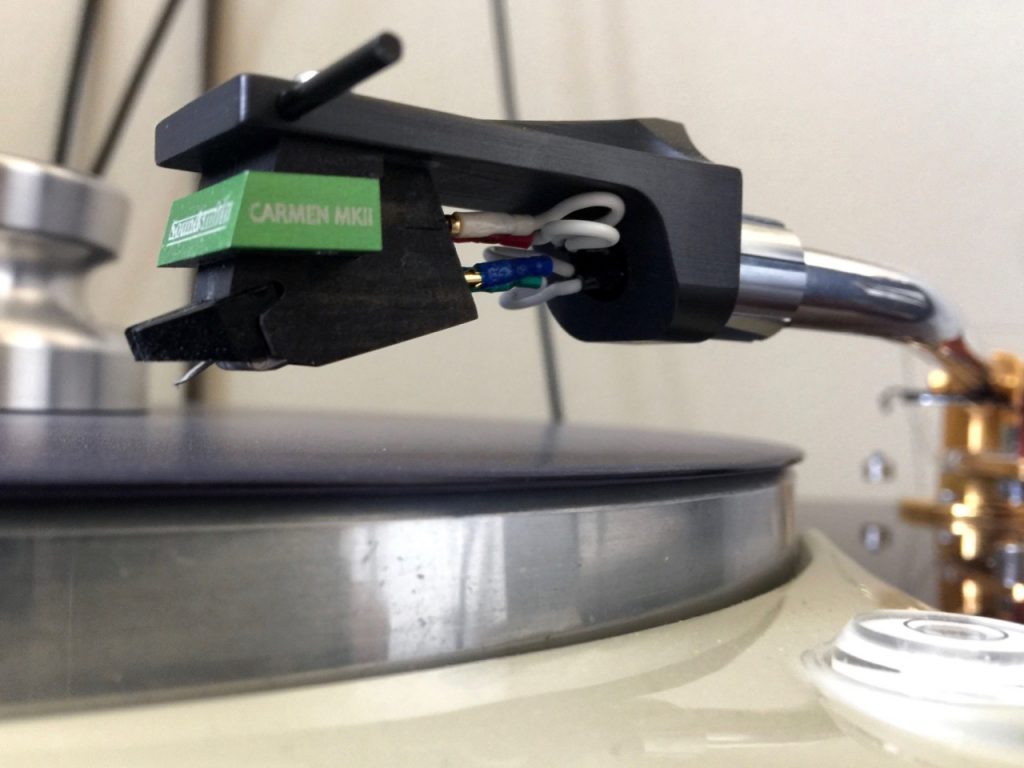
The Soundsmith Carmen Mk II phono cartridge.
Note: I sent my broken Carmen Mk II into Soundsmith and paid for a rebuild for the affordable price of $223.10 USD (including shipping) so I could tell you about the rebuild experience. It took 3 weeks from the time I sent it into Soundsmith, to the time I had it back in my hands, so that part was speedy, particularly so since that amount of time included shipping both ways. In a future post I'll tell you how the rebuilt Carmen Mk II performs, so stay tuned for that in the hopefully not too distant future.
Aside from their great sound quality and musicality, the Zephyr Mk III's and Carmen Mk II's high-output means no step-up transformer is required, keeping costs & complexity to a minimum, something that always appeals to the frugal side of my nature.
Video Sources with the Audio Note (UK) Oto Phono SE Signature Integrated Amplifier
I'll tell you what, there's a synergy between the Audio Note (UK) Oto Phono SE Signature integrated amplifier and vintage Altec loudspeakers that transcends normal audio paradigms.
The Oto and 'Stokowski' Altec loudspeakers combination blew me away with its sheer musicality, and it easily became my 'desert island' pick for just forgetting about everything in audio-land and just immersing myself in the pure enjoyment of listening to the music.
Whether it was direct-to-disc recordings of musical performances from the acoustic (1877 - 1925) and electric (1925 - 1945) eras of recording, or more recent recordings of musical performances from the magnetic (1945 - 1975) or digital (1975 - present) eras of recording, the Oto-Altec combination always had a way of putting the music front and center in a way that deeply connected me with the music.
As it turns out, the same thing happened with the Oto and my vintage Altec A5 Voice of the Theater loudspeakers in my audio-visual system.
I'm not really sure why there is such a synergistic match between the Oto and my 'Stokowski' Altec loudspeakers, or my Altec A5 Voice of the Theater loudspeakers, but there is, and both are amazing combinations for experiencing the 'soul' of the music, or film, as the case may be.
Take note fellow vintage Altec loudspeaker enthusiasts, the Audio Note (UK) Oto Phono SE Signature integrated amplifier is a superb match for vintage Altec loudspeakers.
As much as I have enjoyed my Leben CS-600 integrated amplifier in my audio-visual system as a long-term reference, the Audio Note (UK) Oto Phono SE Signature integrated amplifier is at another level in performance with the Altec A5s, and the fact that the Oto has a high-quality phono stage built into its chassis makes it even more appealing for those moments when I want to spin a little vinyl in my AV system.
When watching video through streaming sources via my Apple TV, or spinning a DVD or Blu-ray Disc in my Oppo, the experience is completely immersive, which I suppose deserves a little more elaboration as to what is going on with the positioning of the loudspeakers and its effect on the 'immersion' experience.
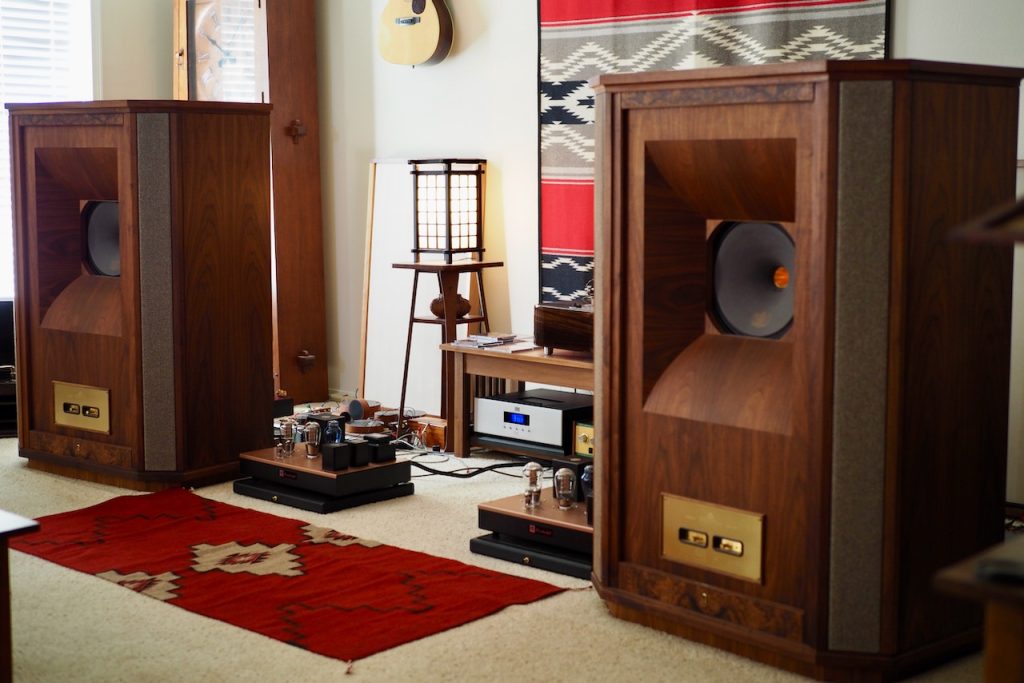
'Audiophile' positioning of the West's places them 77 inches (almost 2 meters) out into the room from the front wall.
Currently my living room music system (above) with my Tannoy Westminster Royal SE loudspeakers is setup in a classic audiophile configuration with the loudspeakers located almost 2 meters out into the room from the front wall, and having about that same amount of distance from the side walls.
When I setup up my loudspeakers in a classic audiophile configuration, say a 'rule of thirds' or 'rule of fifths' type of configuration, it accentuates the visuospatial soundstaging & imaging recording artifacts contained in magnetic and digital era stereo recordings.
This loudspeaker placement still allows mono recordings to sound tonally natural, as long as the system is setup with a 'comparison by contrast' method of system voicing, and those ancient recordings are still extremely enjoyable to listen to and experience from a musical perspective.
That sort of audiophile positioning casts the visuospatial recording cues contained in stereo recordings from the front plane of the loudspeakers back towards the front wall (and beyond), giving a sort of holographic arrangement of the recorded aural stereo images.
Audiophile positioning of loudspeakers favors those loudspeaker-crossover combinations that are optimized for that kind of room positioning, which is typical of loudspeakers marketed to audiophiles.
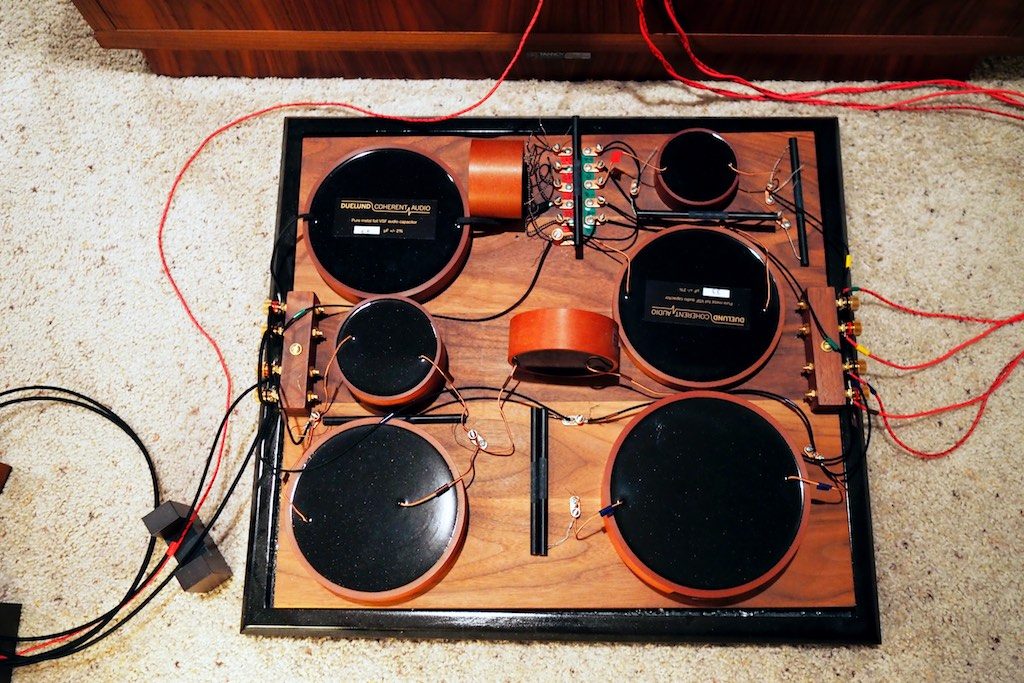
Duelund CAST crossovers for the WRSE's.
Indeed, the Duelund CAST crossovers for my Westminsters (above) have their high- and low-frequency circuits optimized to provide a balanced presentation with that positioning.

Room corner positioning with my vintage Altec A5 Voice of the Theatre loudspeakers.
My other two systems - and soon to be three - when I get my guitar room system setup with the Audio Note (UK) AN-K/SPe loudspeakers, are setup in 'room boundary' positions (i.e. in the room corners).

Vintage Altec Corona 832A loudspeaker in room corner.
Room boundary positioning favors speaker-crossover combinations that are optimized for that sort of positioning, like my vintage Altec Corona 832A loudspeakers with their adjustable Altec N-800F crossovers (above), or my vintage Altec A5 Voice of the Theatre loudspeakers with their Hiraga-san inspired crossovers, and the Audio Note (UK) AN-K/SPe loudspeakers.
One advantage of room boundary positioning is that it tends to make the most deleterious room node effects that compromise fidelity a non-issue.
Another advantage of room boundary positioning is it frees up space in a room where space is at a premium.
That makes room boundary positioning particularly well suited for smaller rooms, or any rooms where it is necessary to keep loudspeakers positioned out of the way due to living space considerations, where loudspeakers sitting out in the middle of a room are an unacceptable alternative.
If you live in a smaller apartment, or have a smaller room for audio, or have a significant other that objects to loudspeakers sitting out in the middle of a room, room boundary loudspeaker positioning may be for you.
Room boundary positioning of loudspeakers can compress the visuospatial depth dimension of soundstage aural cues for magnetic and digital era recordings somewhat compared to the audiophile-style positioning of loudspeakers, but that is the only downside that I have found from an 'audiophile perspective' that tries to maximize soundstage depth.
Personally, I like both approaches to loudspeaker positioning, and each has its own preferred place in an audiophile's, music lover's, or audio-visual enthusiast's life.
My observation is that many music lover's and audio-visual enthusiast's will tend to prefer a room boundary placement for loudspeakers, while audiophiles that primarily listen to magnetic era recordings - where they are trying to maximize the depth dimension of the soundstage - tend to want an audiophile-style loudspeaker setup.
Ok, that's the end of the rabbit-trail for loudspeaker positioning, but I thought it was worth mentioning for context.
Back to the Oto's performance with my vintage Altec A5 Voice of the Theatre loudspeakers in my audio-visual system that are setup in room boundary positions (corners).
Oh, I almost forgot to mention that another important aspect of room boundary positioning - as in my audio-visual system - is that it tends to place the listener within the front part of the soundstage, rather than outside of it as an observer, as with many audiophile-style loudspeaker setups.
For example, while listening with the Oto and A5 combination in my audio-visual system, the sense of being included within the ambience of the soundstage of a movie or TV show as a listener adds an extra level of intimacy / excitement to the experience.
The Oto integrated amplifier fills my audio-visual room with a sense of recorded ambience that engulfs me as a listener, making me feel like I am included in what is going on in the film experience, rather than just viewing / listening to it as an observer.
The Oto presents the aural soundstage of a film recording in room-filling width, with excellent imaging across its width, as well as a reasonably deep soundstage depth dimension.
The somewhat shortened depth dimension of my boundary placement speaker positioning, and almost near-field listening position, puts the aural images at my fingertips in a 'reach out and touch them' sort of way, as I am placed into the soundstage in an immersive way that makes me feel like I am a part of what is going on in the film, and creates an enhanced emotional connection to the foley and music aspects of films in unprecedented fashion.
The Oto sounded smooth, silky, natural, dimensional, and very emotionally involving, with my Altec A5s while watching films.
The Oto's excellent dynamic shadings (both macro and micro), and bass prowess, are particularly well-suited to films, and makes them come alive in a 'real sound' sort of way that really enhances the emotional 'mood' that a film is trying to convey.
The Oto presents foley in films in a very real sort of way, and it's not unusual while watching films for me to wonder if I am hearing a foley effect, or if it is an actual sound of something else going on inside or outside my home.
Sometimes I have to hit 'pause' and check it out, as it sounds so real. "Was that my phone ringing or is it film foley?" "Was that sound I heard someone in my entryway, or was it part of the film?"
You get the idea, the Oto makes foley sound so real and present that it can be hard to tell what is film, and what is real, going on around me.
The Oto excels at that trinity of sound qualities that makes films and/or music come to life while listening - tone, dynamics, and presence.
Natural tone, the ability to respond to any dynamic shadings large or small, and a vivid presence of aural images, makes the Oto a magic match to my Altec A5s.
The result of the Oto's prowess with tone, dynamics, and the 'living presence' of aural images is that the drama of films is maximized, which makes me 'jump' in suspense-oriented scenes, or to be drawn into the film experience in more intimate sorts of movie scenes, in an impressive 'you are part of the film' sort of way.
For film's music soundtracks, the Oto renders all of those musical traits like timbral realism (the unique 'voices' of instruments), the resolution of tone color (the ability to distinctly hear the chordal variations resulting from adding additional pitches to three tone triads), melody (the tune you 'whistle while you work'), harmony (treble & bass accompaniments to the melody), rhythm (the steady beat that determines the tempo), tempo (speed), dynamics (variations in loudness), and loudness (the ability to play naturally at live-like levels appropriate to a piece of music), in a particularly realistic and satisfying way.
The combination of the Oto with my A5s performance is so remarkably good that the Oto could easily become my 'forever' integrated amplifier in my audio-visual system. The Oto is just that good, and its price of $7699 USD, it is an extremely good value as a do-it-all integrated amplifier that makes the music and foley of films so incredibly enticing and life-like.
Vinyl with the Audio Note (UK) Oto Phono SE Signature Integrated Amplifier
I typically do my primary music listening in my main music system, but on occasion I like to settle into my cozy audio-visual room to listen to music while spinning a little vinyl.
The value of having a high-quality phono stage in the Audio Note (UK) Oto Phono SE Signature integrated amplifier is not to be underestimated.
I think an integrated amplifier like the Oto that includes a phono stage is by far the most sensible high-performance audio amplification component for most audio enthusiasts, and personally, as good as separates components can be, I almost always prefer an integrated amplifier to separate components.
Having everything in one chassis eliminates the common deleterious interactions that are often present with separate components, is typically less expensive than high-quality separate components, as well as reducing the number of interconnects and high-quality power cords needed to get the best out of system performance.

Audio Note (UK) Oto Phono SE Signature integrated amplifier in my A-V system.
A high-performance integrated amplifier like the Oto makes it less expensive to build a high-fidelity audio system, and easier to get the system voiced and performing in optimum fashion.
In fact, I'm not even aware of a set of separate components - amplifier, preamplifier, and phono equalizer - that can come anywhere near matching the high-fidelity performance of the Audio Note (UK) Oto Phono SE Signature integrated amplifier at anywhere near its price of $7699 USD.
It is also less expensive to maintain an integrated amplifier like the Oto with its low count of vacuum tubes, and the rather inexpensive nature of EL-84 power tubes is a bonus for us frugal types.
Just take a look at the photo above with Oto. The Oto, plus sources and loudspeakers, makes for a simple, and rather elegant system that is easily capable of high-fidelity sound quality, while keeping system complexity and costs to a minimum. I like that.

Jim Hall and Red Mitchell at Sweet Basil.
I really enjoyed listening to the Jim Hall and Red Mitchell LP on the Artisthouse record label (AH 5), which was recorded as a live performance in 1978 at Sweet Basil in New York City.
Jim Hall (guitar) was very fond of Red Mitchell's bass playing, saying that Red's time and feeling was extraordinary, so much so that he didn't really need an accompanist, but Jim's soft comping along with Red's solos was truly impressive, and just right in complementing it.
About dynamics, Jim said, "We're trying to explore the soft end of the dynamic scale ...", and keeping with that goal Jim and Red kept their overall volume on the soft side, so that the audience at Sweet Basil would be drawn into listening to the interplay between them.
The Audio Note (UK) Oto Phono SE Signature integrated amplifier did an excellent job of capturing the time, feeling, softer dynamics, and lower volumes of Jim and Red's performances at Sweet Basil, and presenting it as thoroughly enjoyable musical performances.
The ability of the Oto to portray the natural timbral qualities of Jim's guitar and Red's 200 year old bass was excellent, and the resolution was such that I could hear all the nuances of Jim and Red's articulate guitar and bass playing in a very live-like and satisfying way.
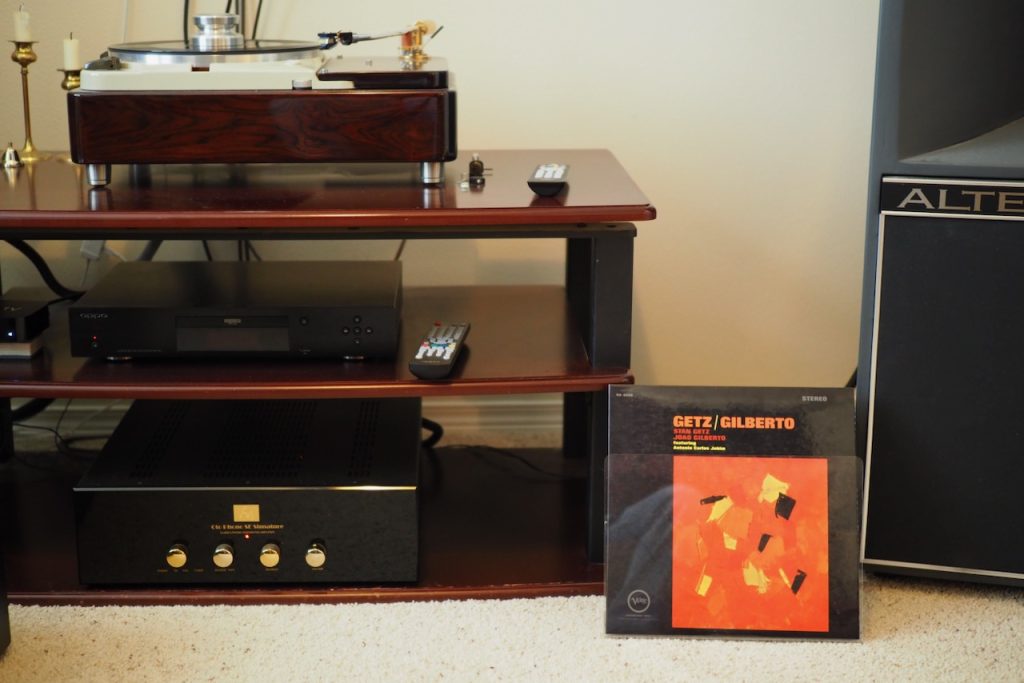
Getz/Gilberto
On the superb 45 RPM Analogue Productions reissue of Getz/Gilberto (above) the Oto did an excellent job at portraying João and Astrud Gilberto's beautiful, rich, and mellow vocals, along with all the timbral qualities of Milton Banana's drum kit, Stan Getz's tenor sax, João's guitar, Antônio Carlos Jobim's piano, and Sebastião Neto's double bass.
While my loudspeaker positioning suppressed the depth dimension of the soundstage somewhat, the Oto still presented a wide soundstage, with a room filling ambience of the recording, and aural images were vividly presented on the soundstage.
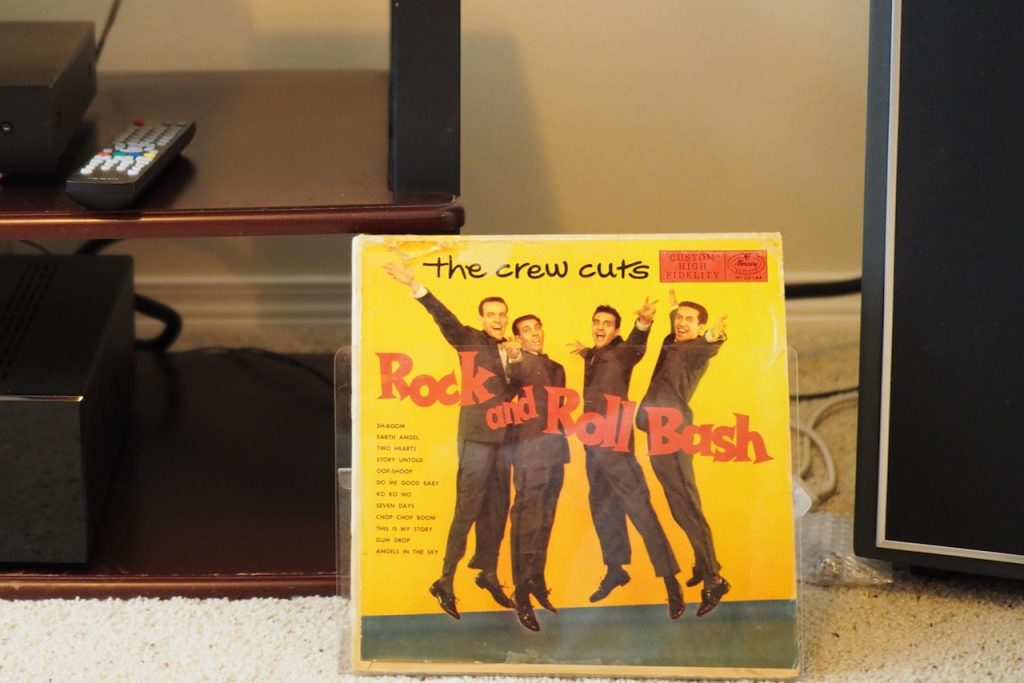
The Crew Cuts' Rock and Roll Bash.
Whether I was listening to audiophile jazz favorites like Getz/Gilberto, or jazz musician favorites like Jim Hall and Red Mitchell, or an early rock & roll album like the 1956 mono recording Rock and Roll Bash by the The Crew Cuts, the Oto always delivered a compelling musical performance that unfailingly got the feel of the music right.
One thing I could always count on with the Oto was that it would make listening to music an enjoyable and fun experience, which is perhaps its most endearing trait.
Summary and Conclusions
The Audio Note (UK) Oto Phono SE Signature integrated amplifier is always a compelling performer, whether I'm enjoying watching movies or TV shows, or listening to an occasional record, in my audio-visual system.
Is there anything I don't like about the Oto? My 'don't like' list is short. My preference would be for a power on/off switch located on the front panel of the Oto rather than on the rear panel, as it would make it easier to turn the Oto on and off when it is in an equipment rack. That's it.
My 'what I like about the Oto' list is lengthy.
First of all, I really like the Oto integrated amplifier because it offers so much performance for the amount of money invested. At $7699 USD the Oto Phono SE Signature is one of the great values in audio.
Second, the design and build quality of the Oto is superb, with quality parts used throughout its design.
Third, the Oto has been completely reliable over the time it has been here. Rock-solid reliability is important to me, and the Oto delivers that in spades.
Fourth, I love that the phono stage is included inside the Oto. First of all, including the phono stage inside the Oto keeps the box count to a minimum. It's also a great design for a phono stage, a zero-feedback design with a CR passive RIAA EQ network, which is one of my favorite approaches to a phono stage. A number of audio designers consider this classic style of phono stage to be "a masterpiece" of phono stage design.
Fifth, I love the performance of singled-ended-pentode EL84 tubes, which are one of the most under appreciated vacuum tubes in audio. EL84 tubes are used in guitar amplifiers to make 'real' music, and they also excel at making 'real' music in the Oto. EL84s are also inexpensive to replace when the time comes, which appeals to the frugal side of my nature. For example, even the premium quad of Watford Valves burst tested Harma EL84s (HERE) that I bought for the Oto came in at a reasonable £96 ($126.50 USD), which is a fraction of the cost to replace a pair of premium direct heated triode output tubes for an SET amp, which can cost over ten times that amount when it comes time for replacement.
Sixth, the Oto possesses excellent sound quality and musicality due to its excellent design and the quality components used in its construction. Andy Grove, who designed the Oto, is one of the resident design geniuses at Audio Note (UK), and is also a musician. Andy knows what real music sounds like, and you can hear that in his design of the Oto. Do you need more performance than the Oto provides? I could easily live with the Oto as my 'forever' integrated amplifier, its just that good.
Seventh, I love the look of the Oto with its black acrylic front panel. It's gorgeous in a demure sort of way.
Two years after my feature review of the Audio Note (UK) Oto Phono SE Signature integrated amplifier in Positive Feedback I'm still as impressed as ever with the Oto's features and performance.
As you can likely tell, I'm a big fan of the Audio Note (UK) Oto Phono SE Signature integrated amplifier.
Highly recommended!
What's coming up next?
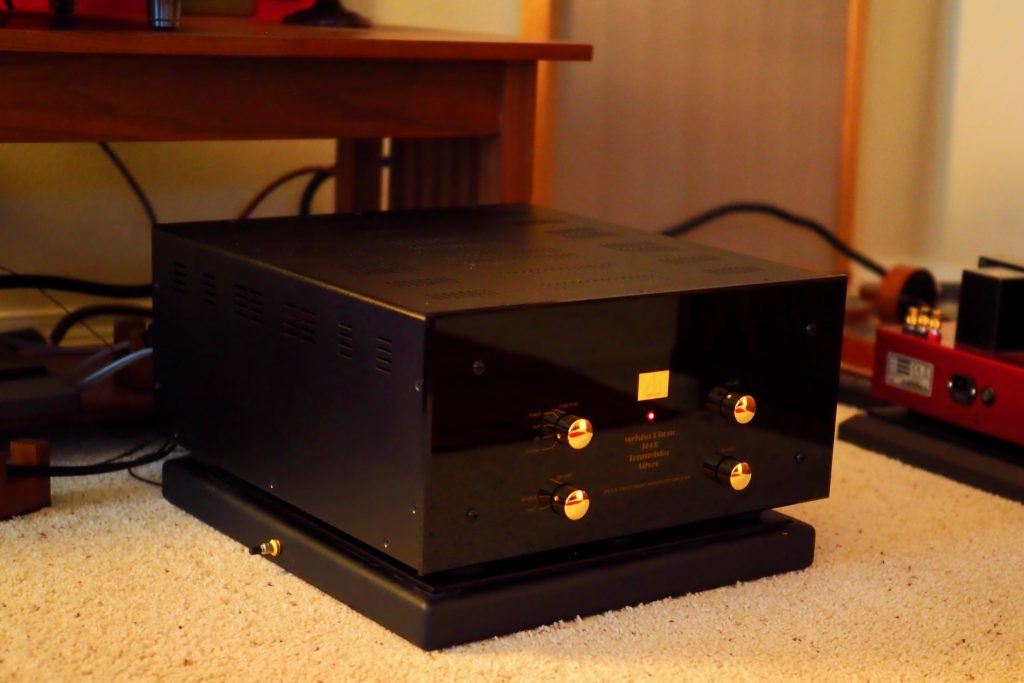
Audio Note (UK) Level 3 300B Meishu Tonmeister Phono Silver integrated amplifier.
There will be more to come about the Audio Note (UK) Oto Phono SE Signature integrated amplifier as I compare it to the Audio Note (UK) Meishu Phono Silver Tonmeister 300B SET integrated amplifier (above), where I'll articulate the differences in performance I heard between the Level 2 Oto and the Level 3 Meishu, to give you an idea of the performance differences between those two levels in the Audio Note (UK) product lines.
In the near term I'll be substituting the Audio Note (UK) Meishu Phono Silver Tonmeister 300B SET integrated amplifier for the Oto in my audio-visual system.
The vintage Altec A5 Voice of the Theatre loudspeakers were famously paired with 300B SET amplifiers in movie theaters, so I am really looking forward to hearing my A5s with the 300B Meishu powering them.
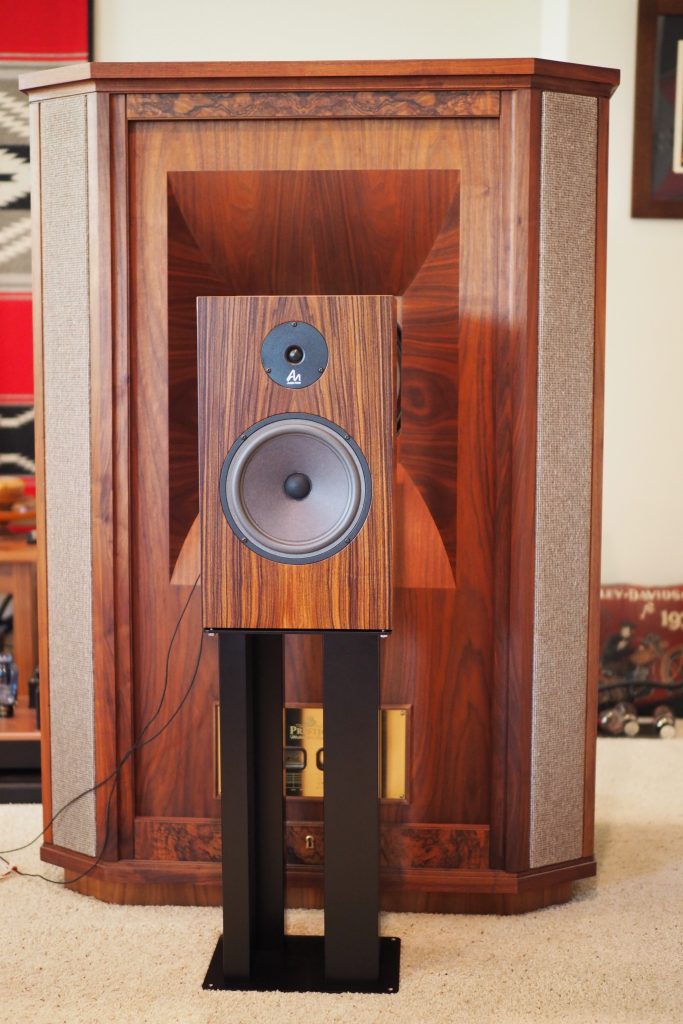
The Audio Note (UK) AN-K/SPe loudspeakers are here!
Additionally, in the future I'll be writing about the Level 2 Oto in the context of a full Audio Note (UK) system that includes the Level 2 Audio Note (UK) CD 2.1x/II as a source (HERE), and Audio Note (UK) AN-K/SPe loudspeakers (see the Today's Fresh Catch HERE).
Lots more Audio Note (UK) adventures to come!
Ok, that's it for now. As always, thanks for stopping by, and may the tone be with you!



























